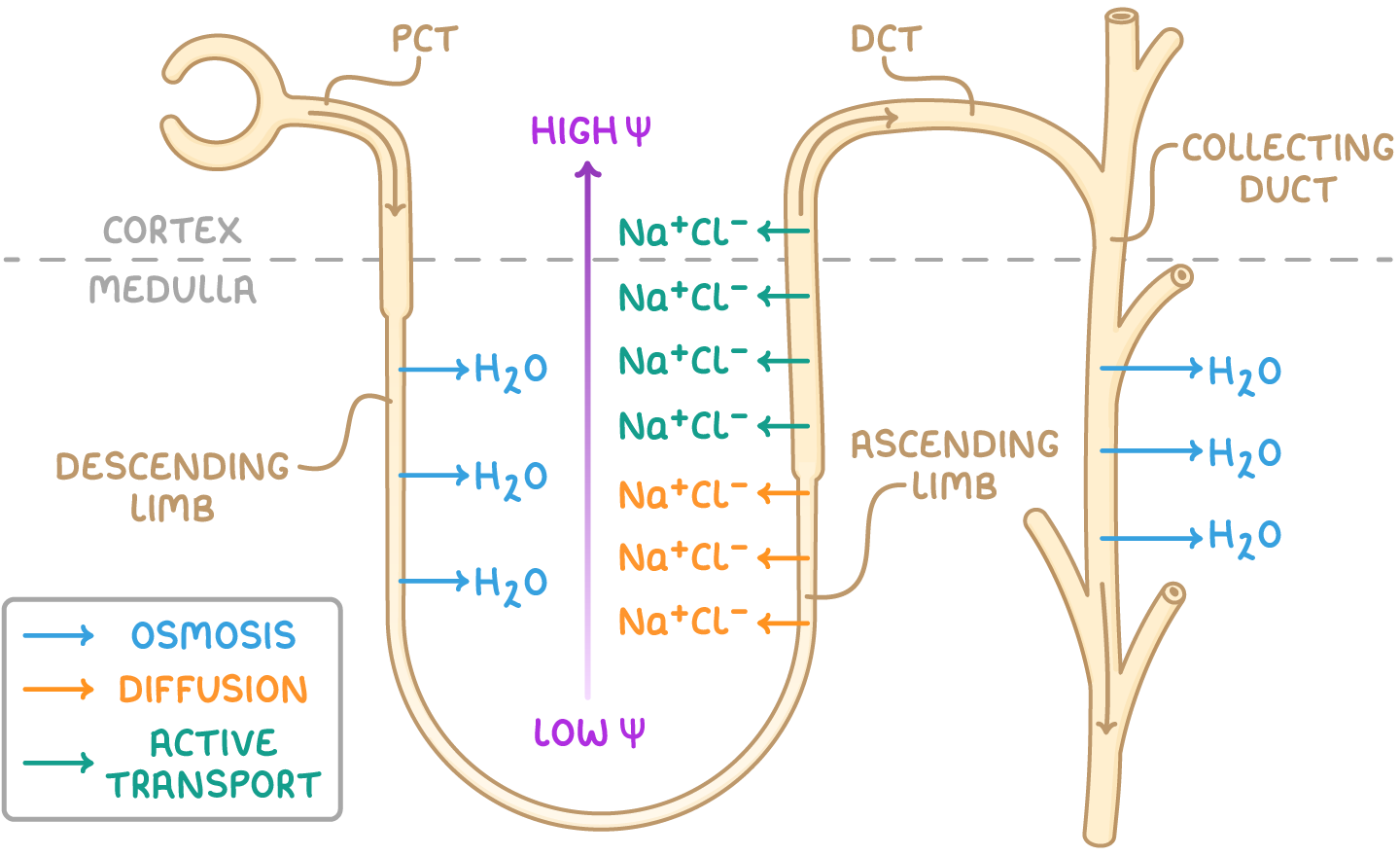The Loop of Henle
This lesson covers:
- The structure and function of the loop of Henle
- How the loop of Henle concentrates urine
- The counter-current multiplier mechanism
The loop of Henle
The loop of Henle is a U-shaped tubule within the kidney nephron. It starts in the renal cortex, it descends into the renal medulla.
It comprises two main sections: the descending limb and the ascending limb.
| Descending limb | Ascending limb | |
|---|---|---|
| Sequence of filtrate travel | First section through which filtrate travels | Second section, following the descending limb |
| Width | Narrow | Wider than the descending limb |
| Permeability to water | Highly permeable | Impermeable |
| Permeability to ions | Impermeable | Permeable |
The loop facilitates the exchange of water and solutes between the tubule and surrounding interstitial fluid, which lets the kidney produce concentrated urine.
How the loop of Henle concentrates urine
The main function of the loop of Henle is to decrease the water potential in the medulla via the active transport of ions out of filtrate into the tissues of the medulla that surround the loop of Henle (interstitial space).
This establishes a water potential gradient that allows water to be reabsorbed into the blood from filtrate in the collecting duct.

Water reabsorption in the loop of Henle:
- The descending limb's walls are permeable to water, so water leaves the filtrate via osmosis into the interstitial space.
- Filtrate loses water as it moves down the descending limb, reaching its lowest water potential at the tip in the medulla.
- Water that is lost is reabsorbed into blood in the surrounding capillaries by osmosis and is carried away.
- The ascending limb is impermeable to water, but is permeable to sodium (Na+) and chloride (Cl-) ions.
- Na+ and Cl- diffuse out of the filtrate into the interstitial space at the bottom of the ascending limb, due to the low water potential of the filtrate.
- This concentrates ions in the interstitial space in the medulla, making its water potential very low.
- Na+ and Cl- need to be actively transported out of the top of the ascending limb, because their concentration in filtrate decreases as it ascends (the water potential increases).
- Overall, this creates a water potential gradient in the interstitial space, with the highest water potential in the cortex and an increasingly lower water potential deeper into the medulla.
Then, when filtrate enters the collecting duct:
- Water moves from the filtrate in the collecting duct into the interstitial space, and then into surrounding capillaries, by osmosis to be carried away.
- Water continues to exit the filtrate as it moves through the collecting duct, even deep in the medulla when most water has already been lost, because of the low water potential established by the loop of Henle in the surrounding interstitial space.
- Urine leaving the collecting duct has a very low water potential, as most water has been reabsorbed into the blood.
Countercurrent multiplier
The loop of Henle operates as a countercurrent multiplier system, intensifying the salt gradient in the kidney medulla.
How the countercurrent multiplier is set up:
- As filtrate moves down the collecting duct, it loses water, decreasing its water potential.
- However, due to the pumping of ions out of the ascending limb of the loop of Henle, especially deeper in the medulla, the water potential of the surrounding tissues in the medulla is even lower than in the collecting duct.
- This allows water to continue to move out of filtrate down the whole length of the collecting duct.
So, the countercurrent system concentrates urine, and ensures that there is always a water potential gradient drawing water out of the collecting duct. If the flows were parallel, less water reabsorption would occur.